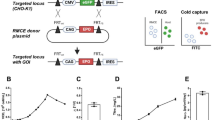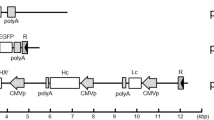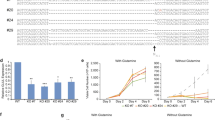Abstract
The growth-factor prototrophk Chinese hamster ovary (CHO) SSF3 cell line was previously adapted for growth in serum-free media. Here we present a newly designed medium which allows these cells to grow in the absence of any exogenously added growth factors. To investigate the capacity of CHO SSF3 cells for the efficient production of recombinant proteins in protein-free media, expression plasmids containing either a human single chain urokinase-type plasminogen activator (uPA)-encoding cDNA or a humanized immunoglobulin G (IgG) kappa light chain cDNA were introduced by transfection. The tryptophan synthase (trpB) gene of Escherichia coli was used as a dominantly acting selection marker allowing the cells to survive in a medium containing indole in place of tryptophan. Some of the clones obtained exhibited a stable uPA expression over a period of several months under selective conditions and the yields were up to 74 mg of uPA/l in a bioreactor and the productivity was around 40 mg/day per 109 cells. The yields of IgG light chains were up to 118 mg/l and the productivity was in the order of 56 mg/day per 109 cells in a bioreactor. These results demonstrate the potential of CHO SSF3 cells for the efficient production of recombinant proteins under protein-free conditions.
This is a preview of subscription content, access via your institution
Access options
Subscribe to this journal
Receive 12 print issues and online access
$209.00 per year
only $17.42 per issue
Buy this article
- Purchase on Springer Link
- Instant access to full article PDF
Prices may be subject to local taxes which are calculated during checkout
Similar content being viewed by others
References
Cumming, D.A. 1991. Glycosylation of recombinant protein therapeutics: control and functional implications. Glycobiology 1: 115–130.
Furukawa, K. and Kobata, A. 1992. Protein glycosylation. Curr. Opinion Biotechnol. 3: 554–559.
Warren, C.E. 1993. Glycosylation. Curr. Opinion Biotechnol. 4: 596–602.
Werner, R.G. and Noé, W. 1993. Mammalian cell cultures. Part I: Characterization, morphology and metabolism. Arzneim.-Forsch./Drug Res. 43: 1134–1139.
Minor, P.D. 1994. Ensuring safety and consistency in cell culture production processes: viral screening and inactivation. Trends in Biotechnology 12: 257–261.
Kimberlin, R.H. 1991. An overview of bovine spongiform encephalopathy. Devel. Biol. Stand. 75: 75–82.
Cleveland, W.L., Wood, I. and Erlanger, B.F. 1983. Routine large-scale production of monoclonal antibodies in a protein-free culture medium. J. Immunol. Meth. 56: 221–234.
Darfler, F.J. 1990. A protein-free medium for the growth of hybridomas and other cells of the immune system. In Vitro Cell. Dev. Biol. 26: 769–778.
Sandstrom, C.E., Miller, W.M. and Papoutsakis, E.T. 1994. Review: Serum-free media for cultures of primitive and mature hematopoietic cells. Biotechnol. Bioeng. 43: 706–733.
Gandor, C.R. 1993. Establishment and characterization of growth-factor-prototrophic Chinese hamster ovary (CHO) cell lines for the production of recombinant proteins. Doctoral thesis, Swiss Federal Institute of Technology.
Butler, M. and Jenkins, H. 1989. Nutritional aspects of the growth of animal cells in culture. J. Biotechnol. 12: 97–110.
Gottesman, M.M. 1987. Chinese hamster ovary cells. Meth. Enzymol. 151: 3–8.
Kaufman, R.J 1990. Mammalian recombinant proteins: structure, function and immunological analysis. Curr. Opinion Biotechnol. 1: 141–150.
Kellems, R.E. 1991. Gene amplification in mammalian cells: strategies for protein production. Curr. Opinion Biotechnol. 2: 723–729.
Reff, M.E. 1993. High-level production of recombinant immunoglobulins in mammalian cells. Curr. Opinion Biotechnol. 4: 573–576.
Kurano, N., Leist, C., Messi, F., Gandor, C., Kurano, S. and Fiechter, A. 1990. Growth kinetics of Chinese hamster ovary cells in a compact loop bioreactor: 3. Selection and characterization of an anchorage-independent subline and medium improvement. J. Biotechnol. 15: 245–258.
Hartman, S.C. and Mulligan, R.C. 1988. Two dominant-acting selectable markers for gene transfer studies in mammalian cells. Proc. Natl. Acad. Sci. USA 85: 8047–8051.
Felgner, P.L., Gadek, T.R., Holm, M., Roman, R., Chan, H.W., Wenz, M., Northrop, J.P., Ringold, G.M. and Danielsen, M. 1987. Lipofection: A highly efficient, lipid-mediated DNA-transfection procedure. Proc. Natl. Acad. Sci. USA 84: 7413–7417.
Messi, F. 1991. Tuning of structure and function of Chinese hamster ovary (CHO) cells by systematic design of defined micro-environments. Doctoral thesis, Swiss Federal Institute of Technology.
Nagamine, Y., Sudol, M. and Reich, E. 1983. Hormonal regulation of plasminogen activator mRNA production in porcine kidney cells. Cell 32: 1181–1190.
Wurm, F. 1990. Integration, amplification and stability of plasmid sequences in CHO cell cultures. Biologicals 18: 159–164.
Avgerinos, G.C., Drapeau, D., Socolow, J.S., Mao, J., Hsiao, K. and Broeze, R.J. 1990. Spin filter perfusion system for high density cell culture: Production of recombinant urinary type plasminogen activator in CHO cells. Bio/Technology 8: 54–58.
Sarubbi, E., Nolli, M.L., Robbiati, F., Soffientini, A., Parenti, F. and Cassani, G. 1989. The differential glycosylation of human pro-urokinase from various recombinant mammalian cell lines does not affect activity and binding to PAI-1. Thromb. Haemos. 62: 927–933.
Nolli, M.L., Sarubbi, E., Corti, A., Robbiati, F., Soffientini, A., Blasi, F., Parenti, F. and Cassani, G. 1989. Production and characterisation of human recombinant single chain urokinase-type plasminogen activator from mouse cells. Fibrinolysis 3: 101–106.
Friedman, J.S., Cofer, C.L., Anderson, C.L., Kushner, J.A., Gray, P.P., Chapma, G.E., Stuart, M.C., Lazarus, L., Shine, J. and Kushner, P.J. 1989. High expression in mammalian cells without amplification. Bio/Technology 7: 359–362.
Leist, C.H., Meyer, H.-P. and Fiechter, A. 1986. Process control during the suspension culture of a human melanoma cell line in a mechanically stirred loop bioreactor. J. Biotechnol, 4: 235–246.
Kurano, N., Leist, C., Messi, F., Kurano, S. and Fiechter, A. 1990. Growth kinetics of Chinese hamster ovary cells in a compact loop bioreactor: 1. Effects of physical and chemical environments. J. Biotechnol. 15: 101–112.
Kurano, N., Leist, C., Messi, F., Kurano, S. and Fiechter, A. 1990. Growth kinetics of Chinese hamster ovary cells in a compact loop bioreactor: 2. Effects of medium components and waste products. J. Biotechnol. 15: 113–128.
Asselbergs, F.A.M., Bürgi, R., Chaudhurei, B., Heim, J., Meyhack, B., Rajput, B., van Oostrum, J. and Alkan, S. 1993. Localization of epitopes recognized by monoclonal antibodies on tissue-type plasminogen activators using recombinant hybrid enzymes. Fibrinolysis 7: 1–14.
Short, J.M., Fernandez, J.M., Sorge, J.A. and Huse, W.D. 1988. λZAP: A bacteriophage lambda expression vector with in vivo excision properties. Nucl. Acids Res. 16: 7583–7600.
Chung, C.T. and Miller, R.H. 1988. A rapid and convenient method for the preparation and storage of competent bacterial cells. Nucl. Acids Res. 16: 3580.
Nielson, K., Ehret, M. and Mathur, E. 1993. Concentration of dilute protein solutions with StrataClean™ resin. Strategies in Molecular Biology 6: 29.
Laemmli, U.K. 1970. Cleavage of structural proteins during the assembly of the head of the bacteriophage T4. Nature 227: 680–685.
Schägger, H., and von Jagow, G. 1987. Tricine-sodium dodecyl sulfate-polyacrylamide gel electrophoresis for the separation of proteins in the range from 1 to 100 kDa. Anal. Biochem. 166: 268–279.
Reiser, J. and Stark, G.R. 1983. Immunologic detection of specific proteins in cell extracts by fractionation in gels and transfer to paper. Meth. Enzymol. 96: 205–215.
Hawkes, R., Niday, E. and Gordon, J. 1982. A dot-immunobinding assay for monoclonal and other antibodies. Anal. Biochem. 119: 142–147.
Author information
Authors and Affiliations
Rights and permissions
About this article
Cite this article
Zang, M., Trautmann, H., Gandor, C. et al. Production of Recombinant Proteins in Chinese Hamster Ovary Cells Using A Protein-Free Cell Culture Medium. Nat Biotechnol 13, 389–392 (1995). https://doi.org/10.1038/nbt0495-389
Received:
Accepted:
Issue Date:
DOI: https://doi.org/10.1038/nbt0495-389
This article is cited by
-
Application of Genetic Engineering in Biotherapeutics Development
Journal of Pharmaceutical Innovation (2020)
-
Developement of serum-free media in CHO-DG44 cells using a central composite statistical design
Cytotechnology (2007)



